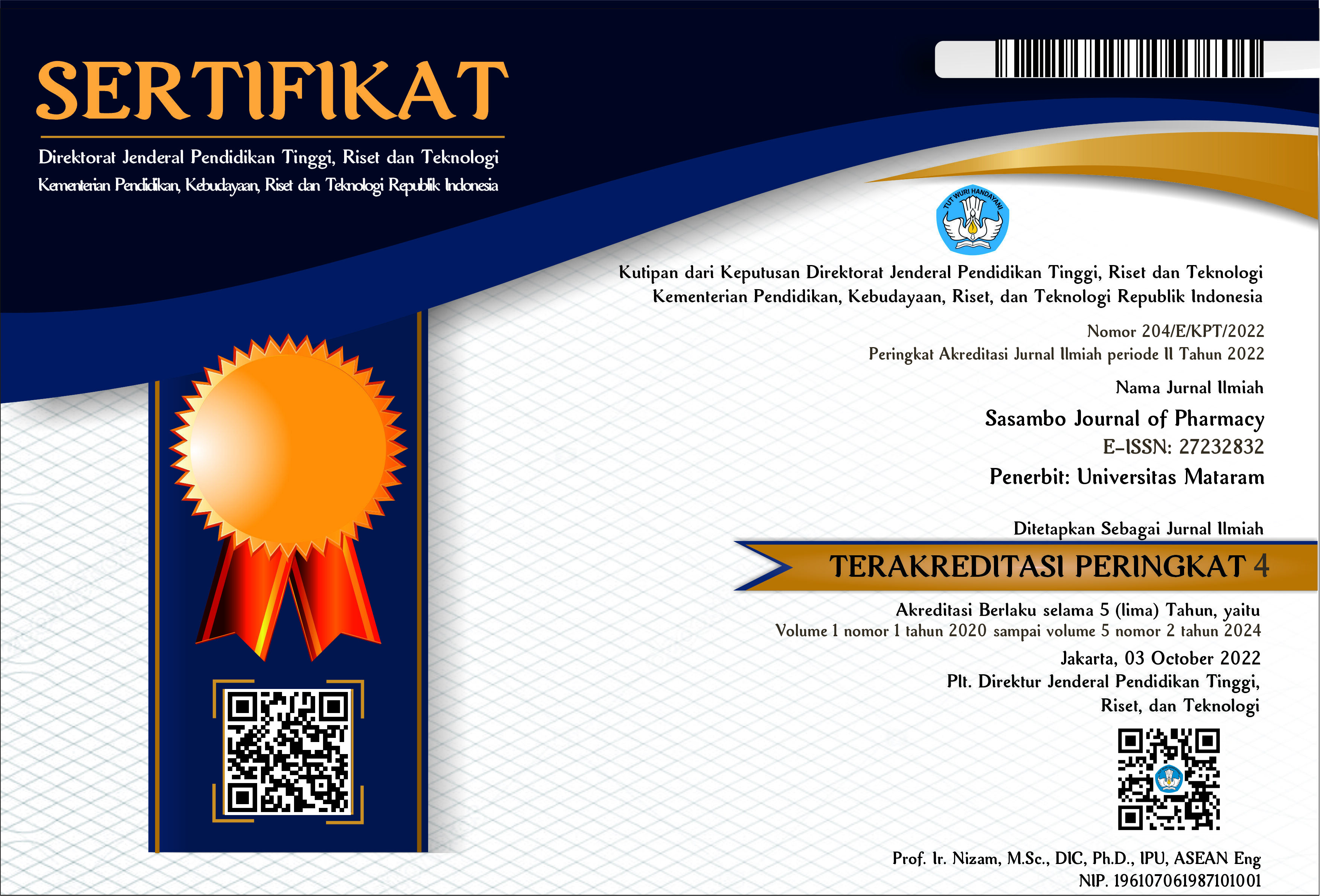The effect of sodium metabisulfite concentration on the physicochemical stability of an L-Ascorbic Acid face mist formulation
DOI:
10.29303/sjp.v6i2.623Downloads
Abstract
Face mist is a cosmetic that is included in skin fresheners, is more practical to use, and has the potential to add antioxidants. Vitamin C is one source of antioxidants. Although water-soluble, vitamin C is an antioxidant that oxidizes readily. Sodium metabisulfite must be added to prevent oxidized vitamin C from becoming unstable. Topical treatments containing 0.01–1.0% sodium metabisulfite act as antioxidants. Therefore, a face mist preparation was made with variations in the concentration of sodium metabisulfite, namely 0.25%, 0.5%, and 1%. This study aims to see an increase in the stability of vitamin C face mist preparations with an increase in the concentration of sodium metabisulfite through physicochemical stability testing under real-time storage conditions for 28 days. The parameters to be observed in the stability test include organoleptic test, pH, specific weight, viscosity, and vitamin C levels. The F1 formula with the smallest concentration of sodium metabisulfite (0.25%) has been able to maintain the stability of vitamin C face mist preparations for 28 days of storage
Keywords:
L-Ascorbic Acid, Vitamin C, Sodium Metabisulfite, Face Mist, Oxidative Stability, Cosmetic FormulationReferences
Aboul-Einien, M. H., Kandil, S. M., Abdou, E. M., Diab, H. M., & Zaki, M. S. E. (2020). Ascorbic acid derivative-loaded modified aspasomes: formulation, in vitro, ex vivo and clinical evaluation for melasma treatment. Journal of Liposome Research, 30(1), 54–67. https://doi.org/10.1080/08982104.2019.1585448
Becker, L. C., Bergfeld, W. F., Belsito, D. V., Hill, R. A., Klaassen, C. D., Liebler, D. C., Marks, J. G., Shank, R. C., Slaga, T. J., Snyder, P. W., Gill, L. J., & Heldreth, B. (2019). Safety Assessment of Glycerin as Used in Cosmetics. International Journal of Toxicology, 38(3_suppl), 6S-22S. https://doi.org/10.1177/1091581819883820
Budzianowska, A., Banaś, K., Budzianowski, J., & Kikowska, M. (2025). Antioxidants to Defend Healthy and Youthful Skin—Current Trends and Future Directions in Cosmetology. Applied Sciences, 15(5), 2571. https://doi.org/10.3390/app15052571
Chmielewski, R., & Lesiak, A. (2024). Mitigating Glycation and Oxidative Stress in Aesthetic Medicine: Hyaluronic Acid and Trehalose Synergy for Anti-AGEs Action in Skin Aging Treatment. Clinical, Cosmetic and Investigational Dermatology, Volume 17, 2701–2712. https://doi.org/10.2147/CCID.S476362
Choi, S., Han, J., Kim, J. H., Kim, A., Kim, S., Lee, W., Yoon, M., Kim, G., & Kim, Y. (2020). Advances in dermatology using DNA aptamer “Aptamin C” innovation: Oxidative stress prevention and effect maximization of vitamin C through antioxidation. Journal of Cosmetic Dermatology, 19(4), 970–976. https://doi.org/10.1111/jocd.13081
Chugaeva, U. Y., Raouf, M., Morozova, N. S., & Mahdavian, L. (2023). Effects of l-ascorbic acid (C6H8O6: Vit-C) on collagen amino acids: DFT study. Amino Acids, 55(11), 1655–1664. https://doi.org/10.1007/s00726-023-03339-5
Cimino, P., Troiani, A., Pepi, F., Garzoli, S., Salvitti, C., Di Rienzo, B., Barone, V., & Ricci, A. (2018). From ascorbic acid to furan derivatives: the gas phase acid catalyzed degradation of vitamin C. Physical Chemistry Chemical Physics, 20(25), 17132–17140. https://doi.org/10.1039/C8CP01893F
Dănilă, E., Kaya, D. A., Anuța, V., Popa, L., Coman, A. E., Chelaru, C., Constantinescu, R. R., Dinu-Pîrvu, C., Albu Kaya, M. G., & Ghica, M. V. (2024). Formulation and Characterization of Niacinamide and Collagen Emulsion and Its Investigation as a Potential Cosmeceutical Product. Cosmetics, 11(2), 40. https://doi.org/10.3390/cosmetics11020040
Gérard, V., Ay, E., Graff, B., Morlet-Savary, F., Galopin, C., Mutilangi, W., & Lalevée, J. (2019). Ascorbic Acid Derivatives as Potential Substitutes for Ascorbic Acid To Reduce Color Degradation of Drinks Containing Ascorbic Acid and Anthocyanins from Natural Extracts. Journal of Agricultural and Food Chemistry, 67(43), 12061–12071. https://doi.org/10.1021/acs.jafc.9b05049
Halla, N., Fernandes, I. P., Heleno, S. A., Costa, P., Boucherit-Otmani, Z., Boucherit, K., Rodrigues, A. E., Ferreira, I. C. F. R., & Barreiro, M. F. (2018). Cosmetics Preservation: A Review on Present Strategies. Molecules, 23(7), 1571. https://doi.org/10.3390/molecules23071571
Li, Y., Yang, Y., Yu, A.-N., & Wang, K. (2016). Effects of reaction parameters on self-degradation of L-ascorbic acid and self-degradation kinetics. Food Science and Biotechnology, 25(1), 97–104. https://doi.org/10.1007/s10068-016-0014-x
Lyu, J.-L., Liu, Y.-J., Wen, K.-C., Chiu, C.-Y., Lin, Y.-H., & Chiang, H.-M. (2022). Protective Effect of Djulis (Chenopodium formosanum) Extract against UV- and AGEs-Induced Skin Aging via Alleviating Oxidative Stress and Collagen Degradation. Molecules, 27(7), 2332. https://doi.org/10.3390/molecules27072332
Madnani, N., Deo, J., Dalal, K., Benjamin, B., Murthy, V. V., Hegde, R., & Shetty, T. (2024). Revitalizing the skin: Exploring the role of barrier repair moisturizers. Journal of Cosmetic Dermatology, 23(5), 1533–1540. https://doi.org/10.1111/jocd.16171
Mascarenhas-Melo, F., Mathur, A., Murugappan, S., Sharma, A., Tanwar, K., Dua, K., Singh, S. K., Mazzola, P. G., Yadav, D. N., Rengan, A. K., Veiga, F., & Paiva-Santos, A. C. (2023). Inorganic nanoparticles in dermopharmaceutical and cosmetic products: Properties, formulation development, toxicity, and regulatory issues. European Journal of Pharmaceutics and Biopharmaceutics, 192, 25–40. https://doi.org/10.1016/j.ejpb.2023.09.011
Meščić Macan, A., Gazivoda Kraljević, T., & Raić-Malić, S. (2019). Therapeutic Perspective of Vitamin C and Its Derivatives. Antioxidants, 8(8), 247. https://doi.org/10.3390/antiox8080247
Murphy, B., Hoptroff, M., Arnold, D., Eccles, R., & Campbell-Lee, S. (2021). In-vivo impact of common cosmetic preservative systems in full formulation on the skin microbiome. PLOS ONE, 16(7), e0254172. https://doi.org/10.1371/journal.pone.0254172
Okamoto, N., Bito, T., Hiura, N., Yamamoto, A., Iida, M., Baba, Y., Fujita, T., Ishihara, A., Yabuta, Y., & Watanabe, F. (2020). Food Additives (Hypochlorous Acid Water, Sodium Metabisulfite, and Sodium Sulfite) Strongly Affect the Chemical and Biological Properties of Vitamin B 12 in Aqueous Solution. ACS Omega, 5(11), 6207–6214. https://doi.org/10.1021/acsomega.0c00425
Pal, R. S., Pal, Y., Chaitanya, M., Dogra, S. S., & Srivasatava, P. (2025). A Comprehensive View on Narrative Aspects of Cosmeceutical Agents Intended for Skin Care. Current Drug Therapy, 20(6), 857–863. https://doi.org/10.2174/0115748855305384240611080804
Piersma, B., Wouters, O. Y., de Rond, S., Boersema, M., Gjaltema, R. A. F., & Bank, R. A. (2017). Ascorbic acid promotes a TGF β 1-induced myofibroblast phenotype switch. Physiological Reports, 5(17), e13324. https://doi.org/10.14814/phy2.13324
Santos, K. L. B., Bragança, V. A. N., Pacheco, L. V., Ota, S. S. B., Aguiar, C. P. O., & Borges, R. S. (2022). Essential features for antioxidant capacity of ascorbic acid (vitamin C). Journal of Molecular Modeling, 28(1), 1. https://doi.org/10.1007/s00894-021-04994-9
Sethi, M., Rana, R., Sambhakar, S., & Chourasia, M. K. (2024). Nanocosmeceuticals: Trends and Recent Advancements in Self Care. AAPS PharmSciTech, 25(3), 51. https://doi.org/10.1208/s12249-024-02761-6
Sharma, S., Ahmad, U., Akhtar, J., Islam, A., Muazzam Khan, M., & Rizvi, N. (2023). The Art and Science of Cosmetics: Understanding the Ingredients. In Cosmetic Products and Industry - New Advances and Applications. IntechOpen. https://doi.org/10.5772/intechopen.112925
Song, J.-E., Jun, S.-H., Ryoo, J.-Y., & Kang, N.-G. (2024). Formulation of Ascorbic Acid and Betaine-based Therapeutic Deep Eutectic System for Enhanced Transdermal Delivery of Ascorbic Acid. Pharmaceutics, 16(5), 687. https://doi.org/10.3390/pharmaceutics16050687
Temova Rakuša, Ž., Pišlar, M., Kristl, A., & Roškar, R. (2021). Comprehensive Stability Study of Vitamin D3 in Aqueous Solutions and Liquid Commercial Products. Pharmaceutics, 13(5), 617. https://doi.org/10.3390/pharmaceutics13050617
Teng, Y., Huang, Y., Tao, X., Fan, Y., & You, J. (2025). Emerging role of ferroptosis in ultraviolet radiation-driven skin photoaging: a narrative review. Photochemical & Photobiological Sciences, 24(3), 531–542. https://doi.org/10.1007/s43630-025-00691-1
Wang, D.-Q., Li, X., Zhang, R.-Y., Yuan, C., Yan, B., Humbert, P., & Quan, Z.-X. (2023). Effects of Investigational Moisturizers on the Skin Barrier and Microbiome following Exposure to Environmental Aggressors: A Randomized Clinical Trial and Ex Vivo Analysis. Journal of Clinical Medicine, 12(18), 6078. https://doi.org/10.3390/jcm12186078
Wang, M., Wang, Z., Zhou, X., & Li, S. (2019). Efficient Removal of Heavy Metal Ions in Wastewater by Using a Novel Alginate-EDTA Hybrid Aerogel. Applied Sciences, 9(3), 547. https://doi.org/10.3390/app9030547
License
Copyright (c) 2025 The Author(s)

This work is licensed under a Creative Commons Attribution 4.0 International License.
Authors who publish with Sasambo Journal of Pharmacy (SJP), agree to the following terms:
- Authors retain copyright and grant the journal right of first publication with the work simultaneously licensed under a Lisensi Creative Commons Atribusi 4.0 Internasional. This license allows authors to use all articles, data sets, graphics and appendices in data mining applications, search engines, web sites, blogs, and other platforms by providing an appropriate reference. The journal allows the author(s) to hold the copyright without restrictions and will retain publishing rights without restrictions.
- Authors are able to enter into separate, additional contractual arrangements for the non-exclusive distribution of the journal's published version of the work (e.g., post it to an institutional repository or publish it in a book), with an acknowledgment of its initial publication in Sasambo Journal of Pharmacy
- Authors are permitted and encouraged to post their work online (e.g., in institutional repositories or on their website) prior to and during the submission process, as it can lead to productive exchanges, as well as earlier and greater citation of published work (See The Effect of Open Access).







